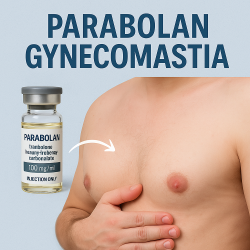 Parabolan Gynecomastia: The Estrogen-Free Risk Bodybuilders Still Face
Parabolan Gynecomastia: The Estrogen-Free Risk Bodybuilders Still Face
⚠️ Introduction: The Paradox of Non-Aromatizing Gyno
Parabolan — chemically known as Trenbolone Hexahydrobenzylcarbonate — is often praised for being immune to estrogenic side effects. Because it does not aromatize (convert to estrogen), many users believe they’re completely safe from developing gynecomastia (gyno) while using it.
But that assumption is dangerously incomplete.
Yes, Parabolan won’t spike estrogen. But it can still cause gyno—and the culprit is prolactin, not estradiol.
In this guide, we’ll break down the misunderstood connection between Parabolan and gynecomastia, explore how it occurs, who’s at risk, and what to do if symptoms appear.
🧬 What Is Parabolan?
-
Chemical name: Trenbolone Hexahydrobenzylcarbonate
-
Class: 19-nor anabolic steroid
-
Half-life: ~10–14 days (long-acting)
-
Derived from: Nandrolone
-
Aromatization: None
-
Prolactin activity: Elevated via progesterone receptor binding
💡 Parabolan is not estrogenic — but it’s progestogenic.
That matters, because progesterone and prolactin are powerful hormones that can mimic estrogen’s breast-stimulating effects in males.
👨⚕️ How Can Parabolan Cause Gynecomastia?
Gynecomastia (development of male breast tissue) is typically caused by an imbalance between:
-
Estrogen (growth-promoting)
-
Androgens (growth-suppressing)
-
Prolactin (can stimulate mammary tissue, especially in the presence of progesterone)
✅ Here’s how Parabolan creates risk:
-
Binds to progesterone receptors
-
Increases prolactin secretion from the pituitary gland
-
Suppresses natural testosterone, reducing anti-estrogenic protection
-
Stacks poorly with aromatizing compounds, compounding estrogenic risk
This environment leads to gyno-like symptoms even without high estradiol levels.
⚠️ Symptoms of Prolactin-Induced Gyno from Parabolan
-
Puffy, itchy, or tender nipples
-
Slight breast tissue swelling
-
Clear or milky discharge (rare, but possible)
-
Libido crashes
-
Erectile dysfunction (ED)
-
Emotional numbness or flatness
🧠 These symptoms are often misdiagnosed as estrogen-related, leading users to overdose AI (which worsens prolactin dominance).
🧪 How to Confirm the Cause
📍Bloodwork is essential. Without it, you’re guessing.
| Marker | Ideal Test Range | Why It Matters |
|---|---|---|
| Prolactin | <15 ng/mL (depending on lab) | Confirms hyperprolactinemia |
| Estradiol (E2) | Normal or low in Parabolan users | Rules out estrogen-based gyno |
| Progesterone | Optional, for full insight | Identifies receptor sensitivity |
| Testosterone | Often suppressed during cycle | Reveals hormonal imbalance |
🛠️ How to Prevent or Reverse Gyno on Parabolan
✅ 1. Use Cabergoline or Pramipexole (Dopamine Agonists)
These lower prolactin by activating dopamine receptors in the brain.
Cabergoline Protocol:
-
0.25 mg twice per week (start low)
-
Increase only if symptoms persist
-
Use for 4–6 weeks, then taper
✅ 2. Don’t Overdo Aromatase Inhibitors (AI)
Too much Arimidex or Letrozole can crash estrogen, giving prolactin free reign. Balance is key.
✅ 3. Monitor Early Signs
Don’t wait until you feel a lump. If nipples feel “off,” test prolactin immediately.
✅ 4. Keep Estrogen In Check If Stacking with Test
Parabolan doesn’t aromatize, but if you’re stacking with testosterone, you still need a low-dose AI (e.g., Arimidex 0.25 mg EOD).
🚫 What NOT to Do
| Mistake | Consequence |
|---|---|
| Using Letrozole alone | May worsen prolactin imbalance |
| Ignoring symptoms for weeks | Permanent tissue growth |
| High-dose AI without bloodwork | Hormonal crash, low libido, mental fog |
| No dopamine support | Gyno + depression + sexual dysfunction |
✅ The most effective fix starts with the right diagnosis.
✅ Final Verdict: Know the Hormone Behind the Symptom
Parabolan doesn’t aromatize — and that makes it more dangerous in some ways, not less. Estrogen gyno is manageable with an AI. Prolactin-based gyno is stealthier, harder to detect early, and requires a different approach altogether.